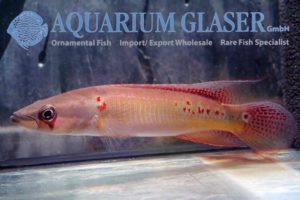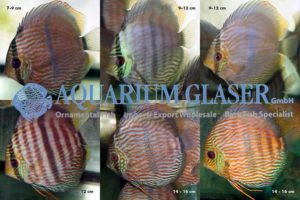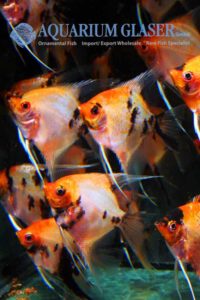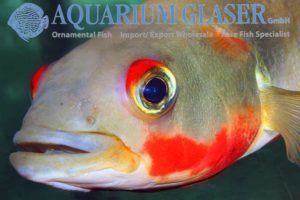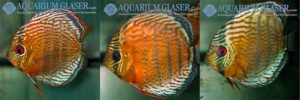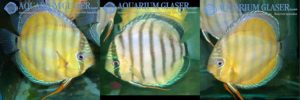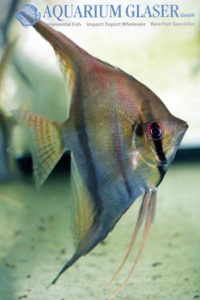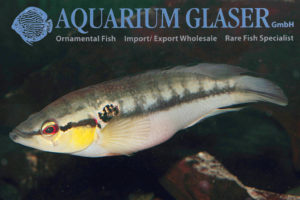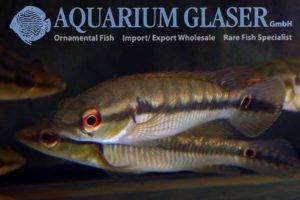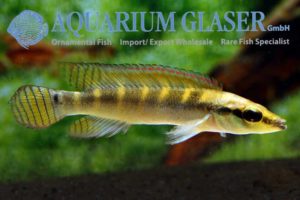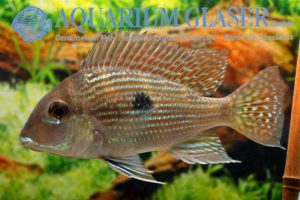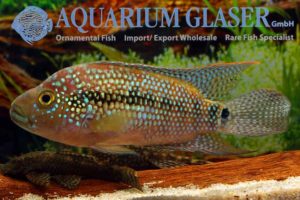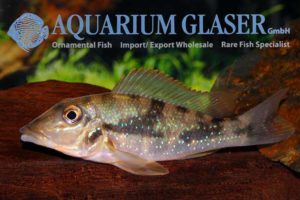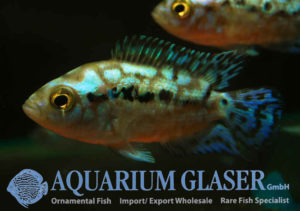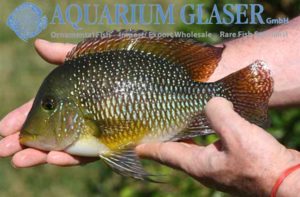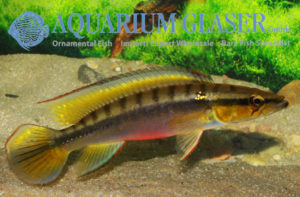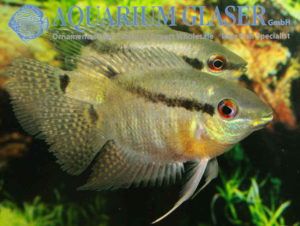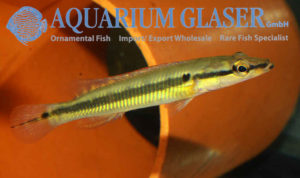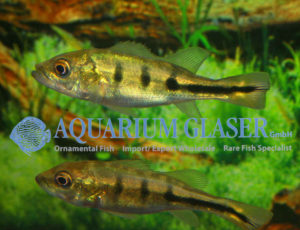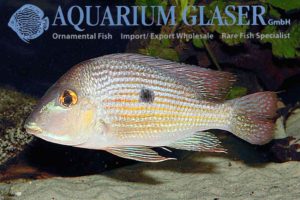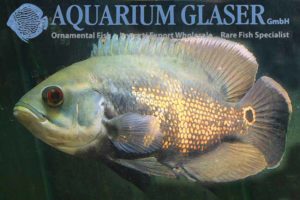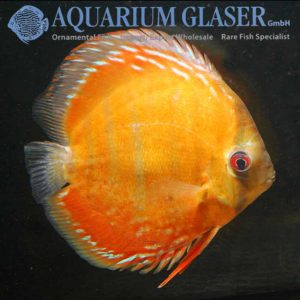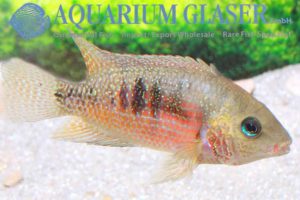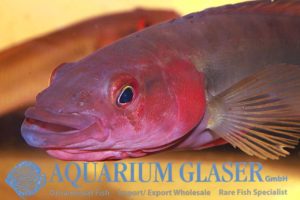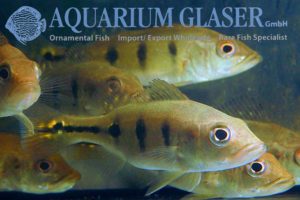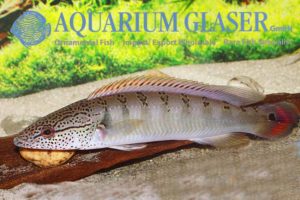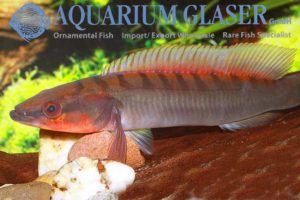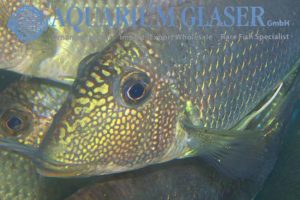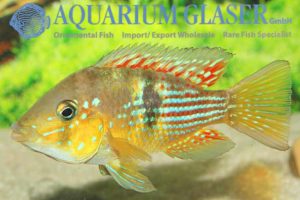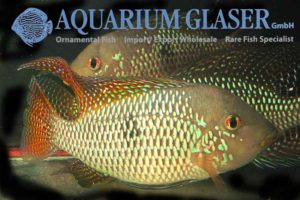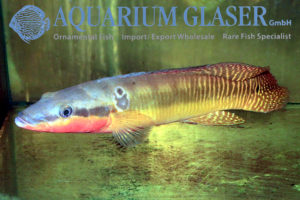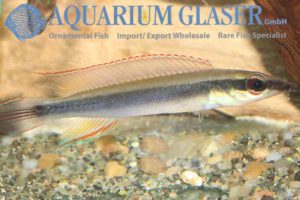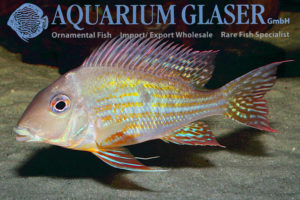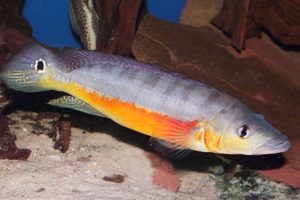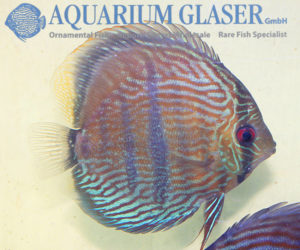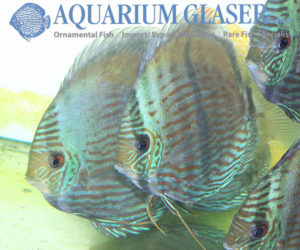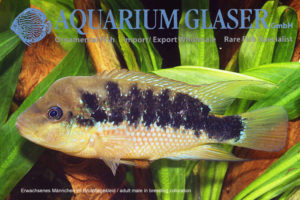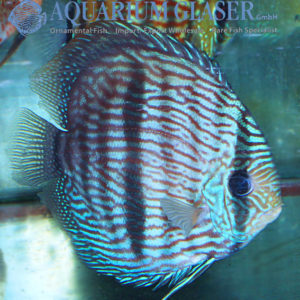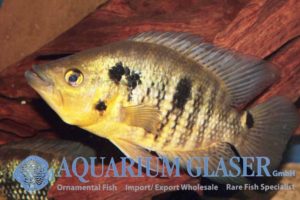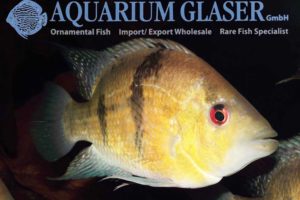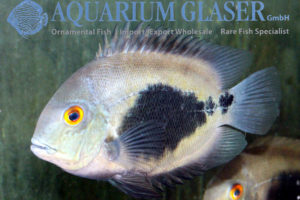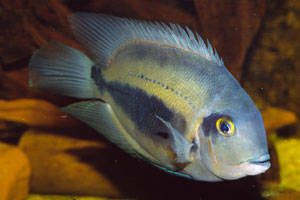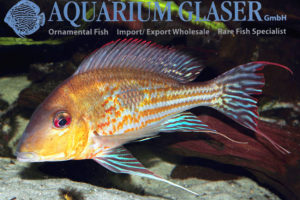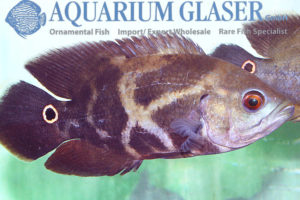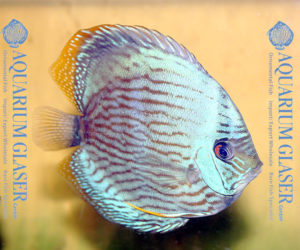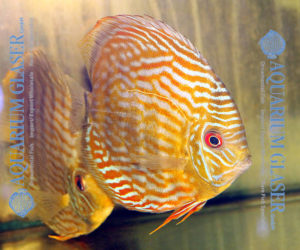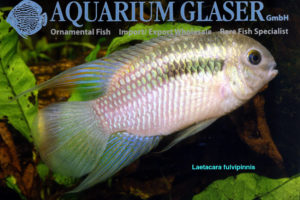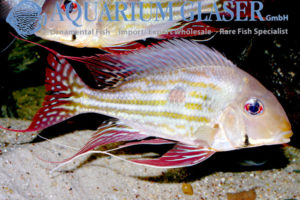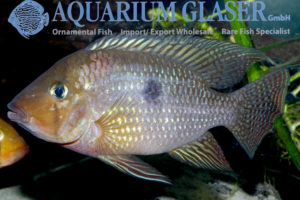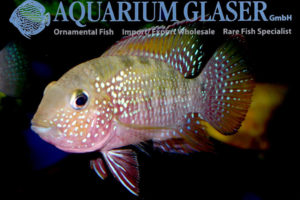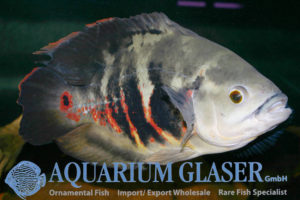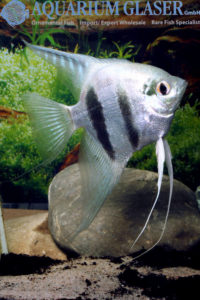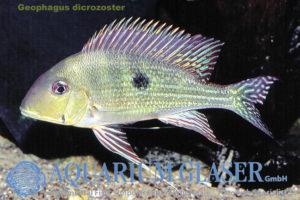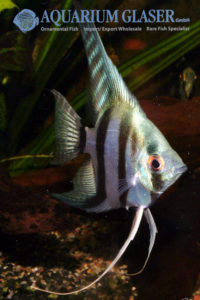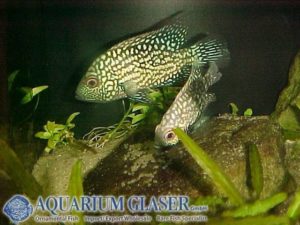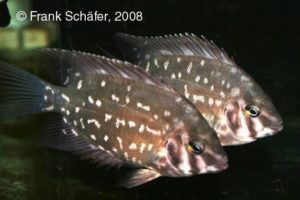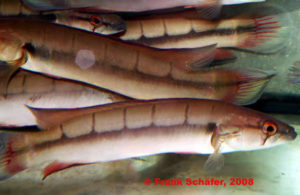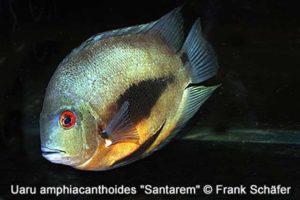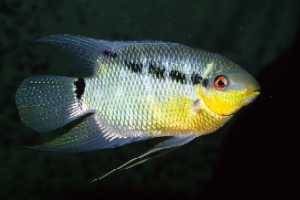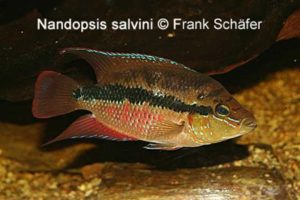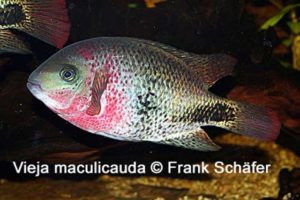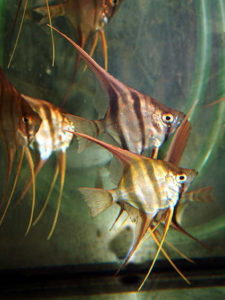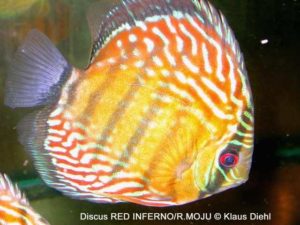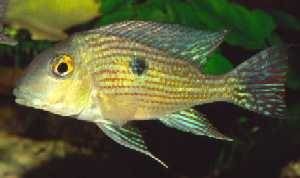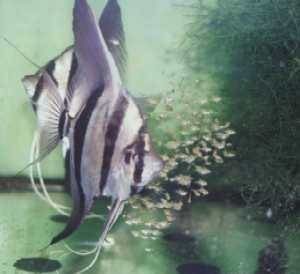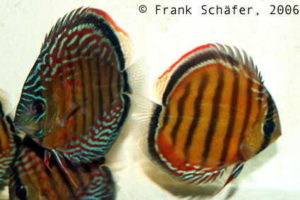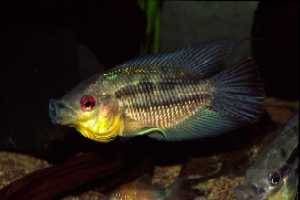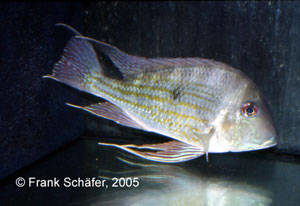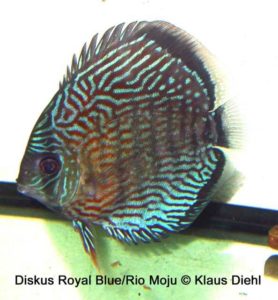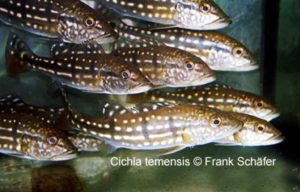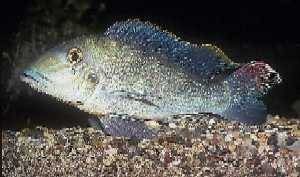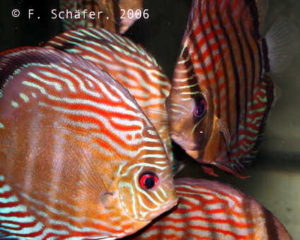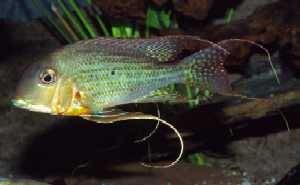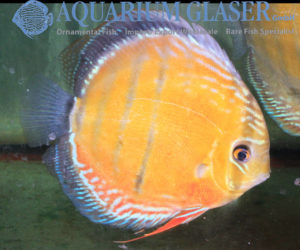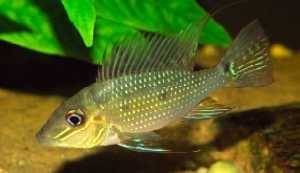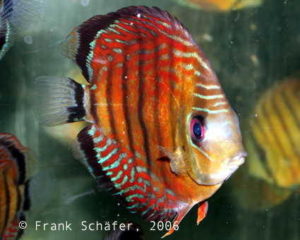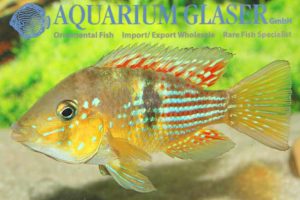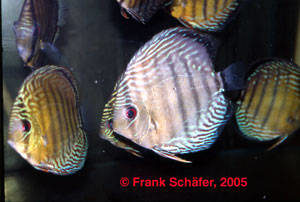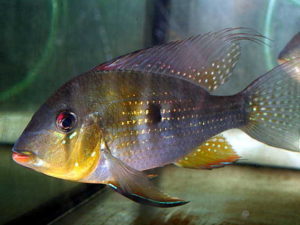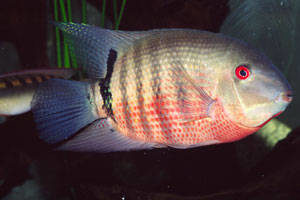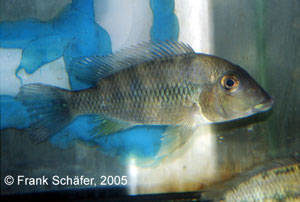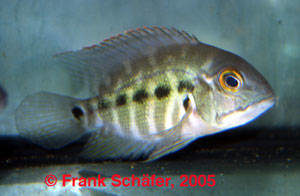Two days ago we were able to import a single specimen of pike cichlid , which we have never seen before. The animal for sure belongs to the rambling relationship of Crenicichla saxatilis; however, no scientific description on a species exist that has red instead of black markings on the body. Our specimen – most […]
25e. Perchlike fishes (5): Remaining Cichlids from South and Central America (295)
-
-
Diskus wild Heckel Blue Uatuma
We obtained very nice Discus Heckel in different sizes from the Uatuma river. The patterns of the individual fish vary a lot, but all of them have a lot of blue color in the horizontal stripes of the body. Even some blue headed fish are among these discus. All pictures are taken from fish that […]
-
Scalare Super Red Devil
We currently received this unique selected sport of the angel in sizes md – xlg. The colours are breathtaking! Available in limited numbers only. For our customers: the fish have code 697574 on our stocklist. Please note that we exclusively supply the wholesale trade. Text & photo: Frank Schäfer
-
Crenicichla lugubris Jutai
Jutai is a municipality in western Brazil, named after the Rio Jutai, which is an affluent to the Amazon river. From this region originates the impressive, beautiful Crenicichla lugubris, which we could import in very small numbers. The females can be recognized by the broad white seam in the dorsal fin. Currently our specimens are […]
-
Discus wild Royal Green Tefé
This wonderful coloured green discus from Tefé is available in very limited numbers only! For our customers: the animals have code 737005 on our stocklist. Please note that we exclusively supply the wholesale trade. Text & photos: Frank Schäfer
-
Discus Gold Xingu
We were able to obtain for the first time some brown discus from the Rio Xingu. The animals are very stout and healthy. Dominant individuals become yellow-golden all over the body. For our customers: the fish have code 732605 on our stocklist. Please note that we exclusively supply the wholesale trade. Text & photos: Frank […]
-
Pterophyllum scalare Santa Isabel
We received wonderful wild collected angelfish from the municipality of the city Santa Isabel at the Rio Negro. Like many other fishes from that area – mainly discus and Apistogramma – the angels show a high degree of red coloration on the body. The reason for that phenomenon is unknown to us. The water in […]
-
Crenicichla sp. Bela Union Uruguay
Code number: 673011 Photos: Thomas Weidner
-
Crenicichla sp. Bela Union Uruguay
We received very nice German bred specimens (current size: 5-7 cm) of this pretty pike cichlid. The bright red eyes make it peculiarly attractive. For additional pictures of adult specimens please see http://www.aquariumglaser.de/en/crenicichla-sp-bela-union-uruguay_de_1253.html For our customers: the fish have code 673012 on our stocklist. Please note that we exclusively supply the wholesale trade. Text & […]
-
Crenicichla compressiceps
The season for this wonderful dwarf cichlid has started. Males attain a maximum length of about 8 cm, females stay smaller and become only 6-7 cm long. Both sexes of the variety we currently have in stock has black bands in the vertical fins. Males can be recognized best by the overall shape (larger and […]
-
Geophagus sp. Rio Caete
Once more we were able to import this beautiful eartheater from the Rio Caete in the northeastern part of Brazil. The species is not described scientifically yet, but belongs without any doubt in the close relationship of the species Geophagus parnaibae and G. sp. “Pindare”. In all probability G. sp. Rio Caete attains a similar […]
-
Rocio octofasciata CHIAPAS
We received German bred F1-generation specimens of wild collected Jack Dempsey cichlids with collecting data. The fish is also known in elder literature under the names of Cichlasoma octofasciatum or C. biocellatum. Available for the first time ever, usually only old aquarium strains with unknown origin are traded. For our customers: the fish have code […]
-
Retroculus lapidifer (2)
The species belonging to the genus Retroculus – currently three species are described scientifically, one additional species is still undescribed – have ever been extremely rarities in the aquarium hobby. Finally we are able to offer once more the beautiful Retroculus lapidifer from Brazil. The fish have ideal sizes (3-6 cm and 6-8 cm), but […]
-
Blue Dempsey original strain Argentina!
We managed to import a small number of the original strain of that breathtaking cichlid from Argentina. Although the fish are still very young (3-5 cm) they show already wonderful colours. Available in very limited numbers only! For our customers: the fish have code 657022 on our stocklist. Please note that we exclusiely supply the […]
-
Geophagus brasiliensis MOGE / Uruguay
We received beautiful, very healthy German bred G. brasiliensis. The animals belong to a population from Uruguay and represent the first tank raised generation. The breeder provided to us photographs of the parents, which were taken immediately after collecting in Moge. The pictures show how splendid the fish will look like when they are grown […]
-
Crenicichla sp. VENTUARI
We received this extremely rare species from Venezuela. The fish is a comparatively small (maximum length observed so far is 16 cm), very colorful member of the Crenicichla-saxatilis-group. Available in very limited numbers only! For our customers: the fish have code 673053 on our stocklist. Please note that we exclusively supply the wholesale trade. Text […]
-
Mesonauta mirificus
For the first time ever we can offer these extraordinary nice flag cichlids as German bred (F1). The species originates from Peru. Available in limited numbers only! For our customers: the fish have code 683361 on our stocklist. Please note that we exclusively supply the wholesale trade. Text & photos: Frank Schäfer
-
Crenicichla zebrina
For the first time ever we could import juveniles of this very rare species. For more information, please check: http://www.aquariumglaser.de/en/archiv.php?news_id=345
-
Cichla orinocensis
We currently have this amazing large cichlid in good numbers and an ideal size in stock. The specimens orginate from Venezuela and most of them are 3-5 cm long. This is a perfect size for the acclimatization of these fish in home aquaria. Besides this we also have a few specimens 5-7 cm long in […]
-
Geophagus sp. Gurupi
We received beautiful bred specimes from Thomas Weidner, who published this Geophagus in the German magazine “Amazonas” No 36 (July/August 2011) on page 76 for the first time. The photo of the juveniles shows the fish we currently have in stock, the photos of the adults depict the breeders. For our customers: the fish have […]
-
Astronotus ocellatus WILD
We currently have some large wild collected oscars from Colombia in stock. Although oscars are always available as bred ones, wild collected ones belong to the real rarities in the market. For our customers: the fish have code 632508 on our stocklist. Please note that we exclusively supply the wholesale trade. Text & photos: Frank […]
-
Discus Red Maues / Lago Paraconi
Divine discus of this variety which have a very high degree of red coloration reached us recently. For our customers: the fish have code 739036 on our stocklist. Please note that we exclusively supply the wholesale trade. Text & photos: Frank Schäfer
-
Neetroplus panamensis, variety RED
We have received wonderful German bred specimens of this relative small, very colorful and extreme rarely offered cichlid. Males become around 13 cm long, females stay smaller. According to the latest systematic revision the fish is placed now in the genus Cryptoheros, subgenus Panamius. For our customers: the fish have code 684602 on our stocklist. […]
-
Crenicichla cf. lugubris RED ATABAPO
At least we managed to import a small number of one of the most beautiful pike cichlids at all. Breeding fish become deep red all over the body, and even outside the breeding season the fish are spectacular. For our customers: the animals have code 670715 on our stocklist. Please note that we exclusively supply […]
-
Cichla kelberi
For the first time ever we have Cichla kelberi in stock, a species that was only recognized in 2006. The fish is available only in a very limited number. The species is distinguished from its closest relative, C. monoculus, by the presence of light spots in the pelvic fins, the anal fin and the lower […]
-
Crenicichla lugubris ORINOCO
We received beautiful Crenicichla lugubris from Venezuela in three sizes. It is astonishing how drastically these fishes change their coloration during their onotgenesis. Juveniles that show the typical “French fries pattern” are schooling fish that feel very unsafe when kept alone. Then the fish come in the age of puberty. Now they see congeneers only […]
-
Crenicichla sp. Atabapo
Code 672534
-
Crenicichla lenticulata
Code 670005
-
Crenicichla johanna Puerto Inirida
-
Satanoperca mapiritensis
We obtained this wonderful, glittering eartheater from Venezuela. The size is 15-18 cm. Members of the genus Satanoperca are also called “devilfishes”, but despite this horrible name the fish are extremely peaceful. They live over sandy bottoms which they browse through in search for food. In such a habitat it makes no sense to defend […]
-
Gymnogeophagus meridionalis
Currently we have magnificent (German pond bred!) specimes of that cichlid, which is almost a dwarf cichlid (our fish are between 5-7 cm long and fully mature and in colour) in stock. There is still no agreement among the specialized aquarists, if this form represents a population of Gymnogeophagus meridionalis, G. rhabdotus or if the […]
-
Geophagus iporangensis
There are more exotic fishes that can be kept and bred at least seasonally in garden ponds than most aquarists think of. Among these species are for sure the different types of Brazilian Pearl Cichlids, the Geophagus-brasiliensis-complex. The group is only poorly understood scientifically, but who cares for names if one looks at these glorious […]
-
First import! Crenicichla zebrina arrived
This pike cichlid was discovered only in 2002 and described scientifically in 2008. It originates from the lower Ventuari river, the largest tributary of the upper Orinoco in Venezuela. The Ventuari is a clearwater river. Although the Ventuari river is rather good sampled, the describers of that unique species were not able to obtain more […]
-
Crenicichla cf. regani Orinoco
The pike cichlids (Crenicichla) are one of the world´s most specious genera of cichlid. Currently 85 species are accepted. Many of them grow larger than 20 cm but there are also dwarf species. The beautiful, slender Crenicichla regani, which is said in literature to grow to a maximum size of 15 cm (male) or 8 […]
-
Geophagus altifrons “Alenquer”
Code number: 675003 Photos: Thomas Weidner
-
Crenicichla vittata
Code number: 673612 Photos: Thomas Weidner
-
Discus Heckel Cross
The term “discus Heckel cross” is given for fish with a broader central bar on the body, the so called “Heckel bar”. Despite this the fish are very different and probably also originate from different regions. Among them are real gems, some with a high degree of red body colouration. For our customers: the fish […]
-
Discus Heckel Blue Body Nhamunda
Currently we have beautiful, large Heckel discus from the Rio Nhamunda in stock. The characteristic feature of that variety is the bright blue sash-like band. For our customers: the fish have code 734095 on our stocklist. Please note that we exclusively supply the wholesale trade. Text & photo: Frank Schäfer
-
Cichlasoma istlanum
The large cichlids from Central America are a bit out of fashion currently. That is a sad thing, for hardly any other fish combines in such a perfect matter brillant coloration, personality and interesting behaviour. Of course these fish need large tanks and an equipment that fits their needs, but if these things are given […]
-
Discus champions on a visit
Once more our Japanese friend Mr Akira Ishinabe has placed his discus he displayed in the current discus championship in Duisburg in our facility to give them an opportuntity to rest a bit after the stress of the exhibition before they turn back home to Japan. His Green Wild was able to get the first […]
-
Caquetaia kraussii
In the wild, Caquataia kraussii is something like a million fish. There is literally no waterbody, may it be pond, lake, or river in the Llanos of Venezuela without this cichlid. So the cichlid enthusiast is a bit left alone with the question why it takes so long if one searches for this fish in […]
-
Caquetaia myersi
Caquetaia myersi belongs definetly to the real rarities in the aquaria of the world. The main reason for this is the fact that it occurs in the wild far from the usual collecting sites in Colombia. What makes fishing in those areas even more difficult is the presence of guerilla which has quite different interests […]
-
Uaru amphiacanthoides
Extremely beautiful, fully grown specimens of this amazonian species of cichlid reached us now from Brazil. Uaru are peaceful fishes that can be best compared with discus regarding demands on water quality and temperature. However, Uaru are more or less specialized herbivorous fishes. For our customers: the fish have code 688517 on our stocklist. Please […]
-
Uaru amphiacanthoides
This large cichlid, which can grow up to 30 cm in length, has a wide distribution throughout South America. Despite its modest colouration and considerable size this species is well known in the fish tanks of the aquarium hobbyist, mainly because of the interesting behaviour and the lack of aggressiveness against fellow tank mates. Especially […]
-
Geophagus megasema
There is almost no chance that commercial importations of wild collected Geophagus megasema will ever appear. So it is very welcome that travelling aquarium enthusiast collect such species in areas that are ignored by professional fish collectors and bring them home alive, which makes it possible to develope a captive bred stock. Geophagus megasema was […]
-
Astronotus ocellatus wild, Colombia
The Oscar, Astronotus ocellatus, belongs to the most popular species among the large cichlids. It was imported to Europe in 1929 for the first time. In Asia, many different sports have been bred since. However, the wild ancestors of the Oscar remain somewhat mysterious and little understood. Until recently, only one or two species were […]
-
Discus Heckel / Jatapu
The series of astonishing wild collected discus we are able to offer right now does not break off. Besides the wonderful Royal Blue which we introduced to you last week, we also have excellent Heckel blue-head said to come the Jatapu river. This branch of the Amazon river has an unique mix of fauna found […]
-
Discus Royal Blue Novo Ariguana
Yesterday (2.2.) we received breathtaking beautiful large wild collected discus called Discus Royal Blue Novo Ariguana. All insiders will understand that the fish do not show all of their beauty today, but even what they show is amazing! Text & photo: Frank Schäfer
-
Laetacara araguaiae
Laetacara sp. „Buckelkopf“ described scientifically. Laetacara sp. „Buckelkopf“ is known in the hobby for many years already. The somewhat unusal common name (the German word „Buckelkopf“ means „humphead“) derives from the feature developed by some very old males, but this happens rather seldom. It is a typical dwarf cichlid, the males grow to a length […]
-
Geophagus winemilleri
The main distribution of Geophagus winemilleri is the southern part of Venezuela. Nevertheless most imports come from Brazil, because the species also occurs in the Rio Negro. G. winemilleri becomes often confused with G. proximus and a second, still undescribed or unidentified species. However, G. winemilleri can be identified by the dark spot on the […]
-
Geophagus sp. „Rio Sao Francisco“
This pearl cichlid from the Rio São Francisco can reach a total length of about 25 cm and thus should be kept in relatively large aquaria of 400 litres and more. Although pearl cichlids are known to be relatively aggressive this particular species is quite peaceful if the tank is large enough. Even when taking […]
-
Bujurquina oenolaemus
Bujurquina oenolaemus: This very pretty species of Bujurquina originates from Bolivia and was described scientifically as early as 1987 by Kullander. It took almost 20 years before the first living specimens were brought to Austria, Switzerland and Germany by travelling aquarists. Soon after breeding was successful and so the species was spread in the hobby. […]
-
Astronotus sp. „Bahia Red“
Sadly it was not possible to research if this Astronotus really was collected in the Brazil state of Bahia. Currently no scientific reports of the occurence of the genus in Bahia are known. So we have to leave the question open, if this population was brought to Bahia as a food fish or if they […]
-
Blue Angel Showsize
In January 2009 we presented to you the new blue dwarf angel (http://www.aquarium-glaser.de/en/pterophyllum-scalare-blauer-zwerg–blue-dwarf_en_1071.html). In the meantime the breeders were pretty active and crossed the blue dwarfs onother strains of angels. So now we are able to supply also blue angels in showsize, which are almost as big as angels of other colour varieties. Text & […]
-
Geophagus dicrozoster and G. abalios
The beautiful eartheaters of the Geophagus-surinamensis relationship are among the most colorful cichlids, shining in all colours of the rainbow. There are numerous species and some of them even have colour varieties in different river systems. As these are currently not recognized by scientists, we help ourselves in adding the river´s name behind the scientific […]
-
Pterophyllum scalare Blue Dwarf
In 1949 Werner Ladiges mentions a blue dwarf angel (Pterophyllum scalare) that appeared by chance (problably by mutation) in a large breeding stock before WW2. Beside its unique blue coloration a characteristicly feature of these fishes was their small adult size. They never grew bigger than 5 cm body height. Although this stock survived WW2 […]
-
Herichthys sp. BLUE-GALAXY
(Aug.6th 2008) A brand new star is born: Herichthys sp. Blue-Galaxy. We are proud to be able to supply limited numbers of this this beautiful breeding form for the first time. They are pubescent in a size of 6-8cm, which they have successfully demonstrated in a tank in our office. Since they should not get […]
-
Uaru fernandezyepezi
(9.April 2008)For the first time we can offer some offspring of Uaru fernandezyepezi. The home of this extremely rare cichlid is in the border area of Colombia and Venezuela, where they occur in the area of the Rio Atabapo. From there origin some challenging fishes such the Altum-Angels. Their requirements are similar, the water hardness […]
-
Crenicichla sp.ATABAPO FIRE Venezuela
Last week we got a very small amount of one of the most beautiful pikecichlids: Crenicichla sp.ATABAPO FIRE Venezuela. Sorry for the bad picture, but it was taken directly in a tank in our facility, not in a photo-tank. But it shows how nice this fish is!
-
Uaru amphiacanthoides -Santarem-
At present we can offer this magnificent variant of Uaru amphiacanthoides originating from Santarem. The fish impress by their metallical resplendent body and the cherry red eyes. All Uarus are expressed plant lovers. Beside a meaty nutrition vegetarian food should be offered. The food spectrum is large, almost all fruit and vegetables are accepted and […]
-
Mesonauta insignis
This cichlid, which is growing up to approx. 20cm is living along the catchment area of the Orinoco, whereit mostly lives in slowly flowing or even standing waters. You often find it right in front of the shore, where it inhabits the upper water layer. Regarding the nutrition M. insignis is totally uncomplicated, because these […]
-
Nandopsis salvini
December 2006: At present we can offer a very beautiful, strongly red coloured variant of Nandopsis (Cichlasoma) salvini to you. They origin from South Mexico, Belize and Guatemala, where they live in to the Atlantic ocean heading streams. Like most Central American cichlids they are very easy to keep in middle hard water at pH […]
-
Vieja maculicauda
Vieja (Cichlasoma) maculicauda the Blackbelt Cichlid is one of the larger Central American cichlids. Males can reach about 35 cm overall length. According to its size one needs voluminous aquaria, where their interesting social behaviour can be observed. In their distribution area (Atlantic slope, from the Usumacinta River drainage in Guatemala to the Chagres River […]
-
Pterophyllum altum
The new season began, Pterophyllum altum (Orinoco) is available again. Deep Angels can reach 20cm length and up to 35cm in height. This has to be considered with the tank purchase, it should have a height of at least 70cm. A decoration with large bogwood, provides structure and retreat possibilities for them. Since they are […]
-
Discus „Red Inferno/Rio Moju“
Only one example of at present in extraordinarily good quality arriving Diskus is the “Red Inferno” variant coming from the Rio Moju. On their fins and flanks the animals show a strongly red-orange basic colour, which stands in beautiful contrast to the bluish green wave pattern. The icing on the cake are their cherry-red eyes, […]
-
Geophagus sp. „Pindare“
Among the “Eartheaters”, species Geophagus, G. sp. “Pindare” is one of the most recommendable ones. Growing up to approx. 15cm only, it stays rather small and also shows a beautiful marking with red and blue lines on its flanks. The care of this species is really quite simple, because it does not care about the […]
-
Pterophyllum altum german bred
November 2003: Lately we received German bred Pterophllyum altum. It is worth mentioning that this was a natural brood, eg both parent took care for eggs and the young. Even spawning of the Altum Angel is a remarkeble event. This species tends to get panic attacks when the fish is fully grown. Thus they tend […]
-
Diskus Nhamunda rosé
Nhamunda Rosé is the trade name of a strain of the brown discus Symphysodon aequifasciatus axelrodi originated in the Rio Nhamunda (northern influent of Amazon, west the city Alenquer). Now again some Nhamunda Rosé are available. Characteristic for this variety is the partially laminar high red part of the brown primary colour. Thus they are […]
-
Crenicichla spec. ITAPEMIRIM
We received this extremely colorful species of Crenicichla from the southeastern part of Brazil. In adults the sexes can be distinguished quite easily. Females (see main photo) have an ocellus in the dorsal fin which is missing in males (see additional photo). Moreover, in males the deep red spots are scattered over the body, whereas […]
-
Chaetobranchopsis orbicularis
Chaetobranchopsis orbicularis is a plankton eater, which can reach a total length of up to 20cm. This may be one of the reasons, why it is not getting imported too often, as such nutrition specialists are mostly only interesting for specialists and enthusiasts. Yet the care of this species from Brasil is not neccessarily difficult, […]
-
Geophagus sp. „Tananaco“
This very beautiful representative of the surinamensis complex comes from Venezuela. These are very large animals of approximately 25 cm TL. The requirements of keeping, this species is not much different then the other members of its family. A sandy substrate, lots of shady hiding places like bogwood and round eroded stones, are basic requirements, […]
-
Diskus Royal Blue/Rio Moju
If an increase of beauty and charisma of the at 01.02.06 introduced Diskus variant Red Inferno/Rio Moju is still possible, then by the Royal Blues originating from the same river. When first seeing these fishes I remembered the headline of an old “aquarien magazin” article. In January 1972 Eduard Schmidt Focke a famous german discus […]
-
Cichla temensis
Cichla temensis does not represent a fish for everyone. We could import them from Venezuela, where they are estimated fishes for consumption and sold under the name Tucunare. In its natural environment they can reach an overall length of 1 m with a weight of approximately 10 kg. They grow to be the largest of […]
-
Retroculus lapidifer
To take sensibly care of Retroculus lapidifer, which comes from Rio Tocantins/Rio Araguaia catchment area, you should own quariums with a base of 150 x 60cm minimum, as this species can grow very big (25-30cm). But despite its size you should not socialize it with aggressive cichlids, because it has only a certain self-assertion among […]
-
Diskus Semi royal, Rio Moju
Like the introduced before Discus from the same area (Rio Moju) the “Semi Royal” variant shows a strong red coloration at the seam of their body and their fins. With them the wave pattern is nearly continuous distributed over the entire body. (Photo F. Schäfer, Text K. Diehl)
-
Geophagus altifrons
You can surely excellently argue about taste, but the various populations of Geophagus altifrons could justly conquer a solid place among Cichlid lovers. And one of the most beautiful variants might be Geophagus altifrons “Tapajos”. Additionally, G. altifrons is an easy-to-keep cichlid. It requires aquariums with at least 500 ltr. capacity due to its size […]
-
Diskus „Nhamunda rosé”
Nhamunda Rosé is the trade name of a strain of the brown discus Symphysodon aequifasciatus axelrodi originated in the Rio Nhamunda (northern influent of Amazon, west the city Alenquer). Now again some Nhamunda Rosé are available. Characteristic for this variety is the partially laminar high red part of the brown primary colour. Thus they are […]
-
Satanopera acuticeps
Normally the durable care of Satanopera acuticeps is only possible in soft and sour pH-value. But as it was finally successful to breed this eartheater inside the aquarium, it could be that the bred ones are easier to keep and even easier to breed. So far the breeding was possible furthermore only in soft (< […]
-
Diskus „Red Inferno/Rio Moju“
In the following pictures you see some impressions from our discus installation. Seldom could we offer a so large selection on magnificently coloured, perfectly acclimatized Discus. The animals originating from different areas are even in our facility hardly to exceed in colour splendour. Since all of them attained full growth, breeders can fast extend their […]
-
Gymnogeophagus meridionalis
If you search for a Cichlid for a society aquarium (120 l and up), G. meridionalis is almost unrestricted recommendable. Being a all eatingfish, it accepts every imaginable food, getting only approx. 10-12cm it is not growing too big and it also shows really beautiful colours. Besides it is not choosy regarding the water condition […]
-
Diskus „Wild Lago Inanum“
This very beautiful discus fish is traded as well under the name „Semi Royal Blue“. Wild caught discus fish are just beautiful! It is remarkable that still new wild type varieties are found and imported. Wild caught discus fish will not be feeling themselves well if not kept under optimal conditions. This malcontent will be […]
-
Acarichthys heckelii
January 2007: At present we can offer particularly beautiful Acarichthys heckelii from the region around Santarem. These fish are characterised by an intensive yellow colouring of the body. It forms a beautiful contrast to the red eyes and their magnificent fin rays. Acarichthys heckelii has a large area of origin along the Amazon and the […]
-
Heros severus
Despite the fact that Heros severus is the type species of the Heros genus, this species is the most uncharacteristic representative of this group. This is mainly caused by its reproducing behaviour, which is mouthbreeding and untypical for Heros, because they are all substrate breeding. Also the coloration is different from the other members of […]
-
Geophagus crassilabris
Very large animals, up to 20 cm, came to us from Colombia. These beautiful fish came as well from the Rio Chacu. These eartheaters live in nature in a habitat of moderately flowing streams and rivers. Remarkably for this group of eartheaters is the way they breed their eggs, not as normally in the throat […]
-
Hoplarchus psittacus
This, by specialised hobbyists of large South American cichlid, well known species is only very rarely offered to the public. Our animals were imported from Columbia. The best way to take good care of these beautiful cichlids, which can grow up to 40 cm, is to keep them in large fish tanks with plenty of […]
-
Tahuantinsuyoa macantzatza
The unpronounceable from the Incas empire. So an article about Tahuantinsuyoa macantzatza the Inca Stone Fish could be titled. After fearing over years that they had become extinct, we succeeded to import a larger number of them at the beginning of 2003. For the first time we can offer now both: very beautiful wild caught […]
Wonderful, large Discus from Oriximiná arrived!

Oriximiná lies on the Trombetas river in the Brazilian state of Pará. We obtained from there fantastic, very large Blue Discus in wonderful colours. The fish on the pictures are from our current stock, no archieves photos!
For our customers: the animals have code 731066 on our stocklist. Please note that we exclusively supply the wholesale trade. Available in limited numbers only!
Text & photos: Frank Schäfer
Wonderful wild collected Discus!
The season for Discus has finally started and we are very glad that we can offer a broad selection of different wild collected fish in many sizes and a superb quality. All pictures are taken from the current stock in our fishhouse (no archieves photos).

Diskus Nhamunda-Maracanha, code 731315, size 12-15 cm

Diskus Heckel wild, code 734005, size 12-15 cm

Diskus Heckel Jatapu, code 735055, size 11-15 cm

Diskus Heckel Jatapu, code 735056, size 13-16 cm

Diskus wild Paraconi / A-selected, code 739046, size 14-16 cm
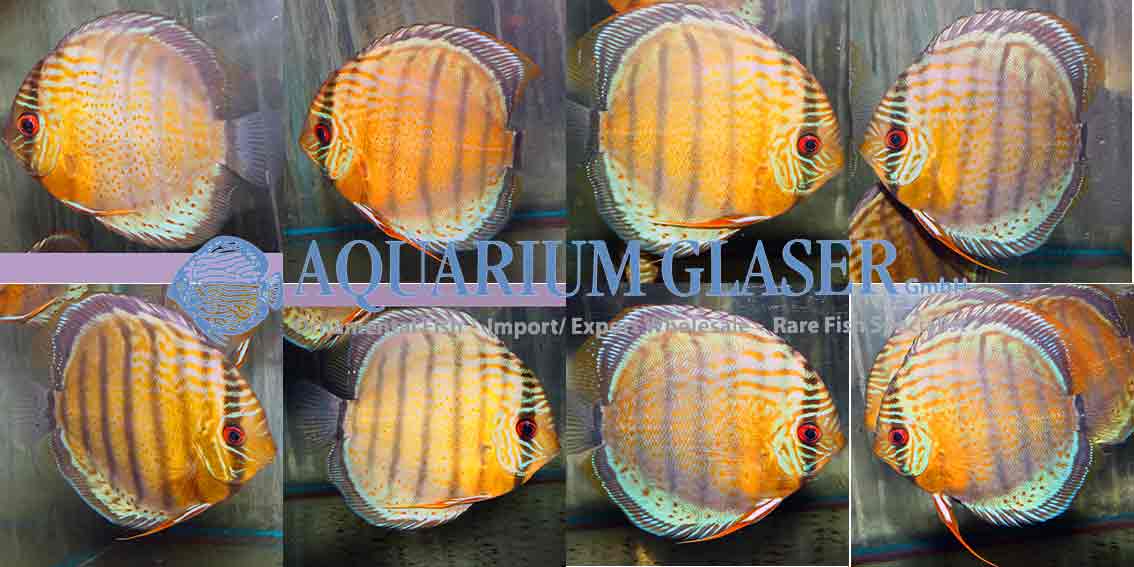
Diskus wild Nanay many spots, code 749944, size 10-14 cm
Text & photos: Frank Schäfer
Blue Dempsey Cichlids German Bred arrived

We received very nice German bred specimens of this breathtaking cichlid. For more information on the species please click here: http://www.aquariumglaser.de/en/fish-archive/southamerican-cichlids-en/_en-4/

For our customers: the fish have code 657132 on our stocklist. Please note that we exclusively supply the wholesale trade.
Text & photos: Frank Schäfer
Scalare Red Devil

Once more we received a wonderful consignment of this attractive sport of the Angel. This time the fish are even more red than usual.
For our customers: the fish have code 697562 on or stocklist. Please note that we exclusively supply the wholesale trade.
Text & photo: Frank Schäfer
Discus season!
The season for wild collected discus is running now and we can offer a great number of marvellous animals, for example from the Nhamunda-Maracanha region (please, see also http://www.aquariumglaser.de/en/fish-archive/discus-en/Diskus_Nhamunda_rose__en/, http://www.aquariumglaser.de/en/news/Nice_Discus_wildcaught_available__en/, http://www.aquariumglaser.de/en/fish-archive/discus-en/Diskus_Nhamunda_rose_en/ and http://www.aquariumglaser.de/en/news/Discus_Royal_Blue_Nhamunda_Maracanha_en/):

731306 Blue Nhamunda Maracanha

731356 Royal Blue Nhamunda Maracanha

731365 Semi-Royal Blue Nhamunda Maracanha

731405 Rose Nhamunda Maracanha
For the first time we have wonderful Discus Caiambe in stock. Although these are wild collected fish, they cannot be assigned properly to the Green or the Brown/Blue Discus. Some specimens have red dots on the flanks, a phenomenon that can be found in Green discus also.

732505 Caiambe

732505 Caiambe

732515 Caiambe Few Spot
And last but not least we also have pretty discus from the Rio Aripuana in a semi-royal selection and a good size in stock.

735995 Semi-Royal Blue Aripuana
(to be continued)
Text & photos: Frank Schäfer
Discus Royal Blue Nhamunda Maracanha

And here comes another fantastic wild collected Discus. Nhamunda discus have some peculiarities. First of all: many have a high content of red colors in their basic coloration. Second: in Nhamunda discus exists a sexual dichromatism and dimorphism. Royal Blue are almost exclusively males, females are usually categorized as “Brown” or “Blue”. Females furthermore have a more roundish, disc-shaped body and males are rather oval-shaped.
For our customers: the fish have code 731355 on our stocklist. Please note that we exclusively supply the wholesale market.
Text & photos: Frank Schäfer
New Names for Goldseam Cichlid and Green Terror

The Goldseam Cichlid from Peru and the Green Terror from Ecuador belong to the most popular cichlids for decades already. The splendid colours, the easy breeding and the fascinating behaviour are responsible for this popularity.
Nevertheless is was unclear for a long time how these fish should be placed systematically. Hobbyists thought that both belong to two different, though closely related species, a point of view that was adopted by most taxonomists, too. So the Goldseam was called Aequidens rivulatus and the Green Terror Aequidens sp. aff. rivulatus (see for example Aqualog Southamerican Cichlids III).

Now recent papers present the results of new investigations, which included not only morphological but also genetical methods. So it was found that the Green Terror belongs really to a new and distinct species. Along with the Goldseam and some other close relatives (Aequidens biseriatus, A. coeruleopunctatus, A. latifrons, A. pulcher, A. sapayensis) he was transferred in the new genus Andinoacara and was named Andinoacara stalsbergi. The Goldseam, however, now should be called Andinoacara rivulatus.
For our customers: A. rivulatus has code 610003, A. stalsbergi 610811 on our stocklist. Please note that we exclusively supply the wholesale market.
Lexicon: Aequidens: Latin, means “with equal tooth”. This refers to the set of teeth. sp. aff.: Latin, abbreviation of “species affinis”, which means “similar species”. rivulatus: Latin, means “originating from a brook”. stalsbergi: in honour of Alf Stalsberg. Andinoacara: means “Acara from the Andes”. Acara is another genus of cichlid.
Literature: Musilová, Z., Schindler, I. und W. Staeck (2009): Description of Andinoacara stalsbergi sp. n. (Teleostei: Cichlidae: Cichlasomatini) from Pacific coastal rivers in Peru, and annotations on the phylogeny of the genus. Vertebrate Zoology 59 (2): 131-141.
Text: Frank Schäfer, photos: Aqualog archieves and Frank Schäfer
Wonderful German Bred South American Cichlids
Some of the larger cichlids of South American belong to the most beautiful freshwater fish at all. We have recently obtained four species of them, all top German bred quality.

Geophagus winemilleri, a breathtaking species from Venezuela, belonging to the Gephagus-surinamensis-group, code 682601

Bujurquina oenolaemus, a splendid Bolivian, a mouthbrooding species from the Aequidens relationship, code 634551

Geophagus sp. Rio Sao Franzisco, an openbrooder that belongs to the Geophagus brasiliensis group and developes much red coloration, code 682131

Astronotus ocellatus “Bahia”, a wild type of oskar which has deep red colours in the belly region when adult, code 633281
More details on those wonderful fish will be availble soon in our fish archieves.
Text: Frank Schäfer, photos: Thomas Weidner
Nice Discus wildcaught available!
Discus wild ROYAL-BLUE Rio NHAMUNDA

Discus wild HECKEL CROSS Rio NHAMUNDA

Discus wild HECKEL CROSS Rio JATAPUA






